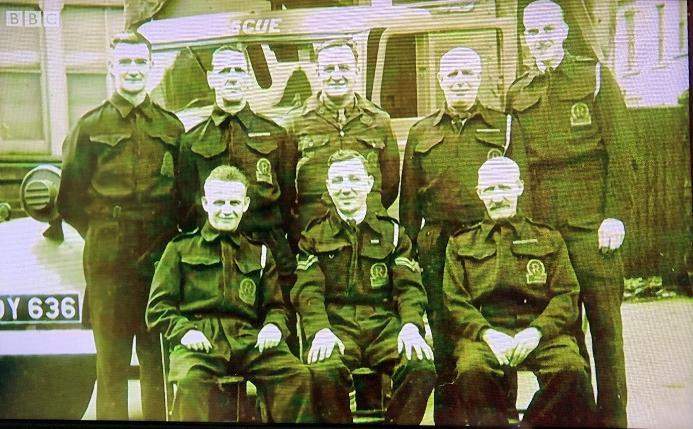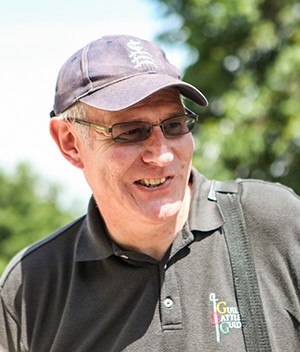The Blitz, A George Medal Award and the Charlton Athletic Connection
26/03/2021 - 1.00
Steve Hunnisett
As a military historian and Blitz tour guide who lives in Charlton, I had long been aware that during the Blitz a member of the Greenwich Rescue Service, Albert Brittan had been awarded a George Medal for his bravery in freeing people from a collapsed row of houses in Charlton Lane, a stone’s throw from The Valley, the home of Charlton Athletic FC. Normally, Mr Brittan and his colleagues would have been a natural subject for my own blog but as I had never been able to find a photograph of him, any further research on him had taken something of a back seat.
However, during the first lockdown last spring, I chanced upon watching an episode of Antiques Roadshow and although it isn’t habitual viewing for me, this particular episode focused on the Battle of Britain and Blitz periods and was therefore surprised and delighted to see Albert Brittan’s daughter proudly showing off her late Dad’s medal, along with a photo of him with his rescue squad. A quick re-run of the programme on catch-up and a screengrab of the photograph and we were in business!

Albert William Brittan (front row, centre) – Author’s photo of screenshot from ‘Antiques Roadshow’
Soon after the lockdown ended, I was lucky enough to get an appointment at the National Archives and it was during this period of research that it became apparent that there was a Charlton Athletic connection, initially quite tenuous but one which would become much stronger once I had finished the research and started writing up the piece on my own blog.
On the night of 8/9 December 1940 at approximately 04:20, close to where the North Kent railway line traverses Charlton Lane via a level crossing, two high explosive bombs fell on a terrace of houses at 19-27 Charlton Lane. The Civil Defence Incident Log records "PEOPLE TRAPPED, 4 FATAL CASUALTIES, 6 TO HOSPITAL, 16 TO FIRST AID POST". Although this description might seem somewhat cold, we must remember that these reports were written in the heat of the moment and as was often the case, the initial casualty list proved to be inaccurate.
Local Air Raid Wardens were quickly on the scene and indeed one of them, Bert Taylor managed to rescue toddler Keith Budden from the ruins. It was clear though that specialist help would be needed and a call went out for a squad from the Greenwich Rescue Service to attend. The leader of the squad that arrived on the scene was 36-year-old Albert Brittan, in peacetime a demolition contractor who lived at Benbow Street in Deptford. He was informed that five people remained trapped inside the ruins of the terrace and he was quickly able to work out that they were probably in the remains of the kitchen of number 25. He set his team to clearing as much of the loose debris as possible and then entered the ruined buildings himself.
He was soon able to rescue a baby, Barry Martin and after passing the infant to his colleagues, he went back into the ruins and after moving a door and beams obstructing his passage, he was able to rescue the baby's mother and carried her out of the building. Returning inside, he next freed a young girl and also recovered the body of an older lady. Shortly after re-entering the building yet again, the roof partially collapsed and almost trapped Albert but he persisted in his work, all the time whilst other bombs were falling and anti-aircraft shell fragments were falling in the vicinity.
After some five hours in the wrecked houses, he was finally able to rescue the final trapped person, a man who had been pinned down by joists from the collapsed floor above. Once he brought him out, only then was Brittan satisfied that all of the trapped occupants had been rescued. His hands were cut and bleeding profusely and needed to be dressed by a doctor from a nearby First Aid Post. This was where the first tenuous connection to Charlton Athletic became apparent, for the doctor happened to Dr John Montgomery, the club doctor and a future director of the Addicks. He was also the company doctor to Siemen’s, a large local employer at the time where my own grandmother had worked during the First World War.
Brittan was recommended for a George Medal by the London County Council, with the recommendation endorsed by Mr Tinslay, Officer in Charge of the Greenwich Rescue Service and by Dr John Montgomery of the Valley First Aid Post – who had witnessed his exploits first-hand – with the award confirmed and gazetted in the London Gazette dated 25 April 1941. The citation concludes thus:
"Brittan was under the debris for five hours without relief and displayed initiative, resource and a high courage. Through his exertions, four persons were rescued alive."
The bombed terrace of houses in Charlton Lane was never rebuilt after the war and today the site forms part of the grounds of Pound Park School but in a way, forms an apt memorial to the five who perished here as well as to the heroic efforts of Albert Brittan and his Rescue Squad who ensured that seven others lived to tell the tale.
It was only later that it became apparent that there was a wider Charlton Athletic connection here as three of the victims, as well as four of those rescued by Albert Brittan and Warden Bert Taylor were from the Budden and Martin families – whose stories are inextricably linked with the very early days of the club’s roots in the Thames-side community of East Street, in what is now called North Charlton.
The Budden family lived next door to Arthur Bryan’s Fish and Chip shop which was located at 77 East Street. It was Arthur who supplied haddock and chip suppers to the young players during the club’s formative years, in an early and unusual form of sponsorship for the fledgling football club. Arthur reputedly also attended matches with a haddock nailed to a stick as an advertisement for his business, when perhaps due to the vagaries of the southeast London accent, the word “Haddock” became corrupted to “Addick”, which became the club’s nickname that persists to this day. The goalposts for the club, which in those early days played in nearby Siemens’ Meadow, were stored in the Buddens’ back garden, as were the players’ boots which were kept in Sam Budden’s garden shed.
Sam Budden (whose real name was William), features in what proved to be the final team photograph taken prior to the outbreak of the First World War and can be seen standing in a cap at the far left of the middle row. Interestingly, the man standing next to him is Fred Chick, one of the Addicks’ three casualties from that conflict, who was killed on 31 August 1916. At the time the photograph was taken, Sam was the team’s Trainer but would later go on to become the volunteer “Clerk of Works” when the waste land in Floyd Road was cleared and turned into the enclosed ground that we now know as The Valley. Sam remained a member of Charlton Athletic until his death on 22 March 1935.

Charlton Athletic FC 1913-14 Team Photo (W. Budden middle row, far left in cap standing next to Fred Chick) – Courtesy of Charlton Athletic Museum.
Arthur Bryan and his wife Dorothy had one child, Kathleen (Kathy) and when Arthur ran into financial trouble (as a result of acting as a guarantor for the club’s debts) in the in the 1920s, Kathy was taken in as a 6-year-old by neighbours Sam and Gertrude Budden. The Buddens had four children of their own – Gladys (who wrapped the fish in Arthur’s shop), Bill, Fred and Dolly. Bill had married Rose Etherton, whose sister had married Bob Kinsey and they in turn had a son – Brian, who would go on to become one of Charlton Athletic’s most famous players. Dolly Budden had married Sid Martin and after the First World War, the Budden and Martin families came together to live at 25 and 27 Charlton Lane, which formed part of the terrace that was destroyed in the Blitz.
Those rescued by Albert Brittan’s squad and by Warden Bert Taylor included Barry Martin (the baby son of Dolly and Sid Martin) as well as his mother Dolly. As we’ve heard, Keith Budden was also rescued, as was his father, Fred. Sadly, though, Barry’s father Sid Martin did not survive and neither did Keith’s mother Florence Budden or his grandmother, Gertrude. It is sometimes reported that Brian Kinsey was one of those rescued from the terrace in Charlton Lane but this is not correct; although he was in Charlton during the Blitz, he lived in nearby Priolo Road and was not involved in this incident.
Happily, though, both Barry Martin and Keith Budden are still very much with us and in normal times still attend matches at The Valley. Both men subsequently married and have children and grandchildren, none of which would have been possible without the heroism of Albert Brittan GM, his rescue squad and Warden Bert Taylor.

Barry Martin (left) and Keith Budden (with snake belt) – Courtesy of Keith Budden
I haven't yet been able to ascertain any real details of what Albert Brittan did subsequently but he appears to have died, aged only 46, on 31 October 1952 in Greenwich, leaving Emma Rose Brittan as his widow. One can only speculate whether his early death was due in some way to his dangerous work as a demolition contractor in an era when health and safety practices were largely absent in the workplace.
In remembrance of those who died here on the night of 8/9 December 1940:
Rachel Miekle Cumming, aged 72, of 27 Charlton Lane
Sidney Martin, aged 32, of 27 Charlton Lane
Florence Lilian Maud Budden, aged 37, of 25 Charlton Lane
Gertrude Budden, aged 59, of 25 Charlton Lane
Desmond Charles Lambert, aged 17, of 23 Charlton Lane
Published Sources:
The Addicks Cartoons – Richard Redden, News Broker Services, 2003
The London Gazette, 25 April 1941
Unpublished Sources:
Metropolitan Borough of Greenwich Civil Defence Incident Log 1939-1945 – Greenwich Heritage Centre
Home Office Inter-Departmental Committee on Civil Defence Gallantry Awards, Case No. 843 – HO 250/19/843 – National Archives Kew
Biography
Steve is now a full time Battlefield Guide, military history blogger and researcher, specialising in the Home Front and London at war in particular, who took the plunge into self-employment in 2015. He is a Southeast London boy by birth and splits his football watching time between Charlton Athletic and Dulwich Hamlet FC, being a season ticket holder at both clubs. He has developed a great interest in the history and heritage of both these community-oriented clubs and is the author of ‘For Freedom’, which tells the story of Dulwich Hamlet’s Second World War casualties.

Steve Hunnisett, Blog Author


/prod01/wlvacuk/media/departments/digital-content-and-communications/images-2024/240328-Varsity-Line-Up-Resized.jpg)
/prod01/wlvacuk/media/departments/digital-content-and-communications/images-18-19/220325-Engineers_teach_thumbail.jpg)
/prod01/wlvacuk/media/departments/digital-content-and-communications/images-18-19/240509-Find-the-Captain-Pencil-Drawing-Resized.jpg)
/prod01/wlvacuk/media/departments/digital-content-and-communications/images-2024/240320-Uzbekistan-Resized.jpg)
/prod01/wlvacuk/media/departments/digital-content-and-communications/images-2024/240229-The-Link-Resized.jpg)